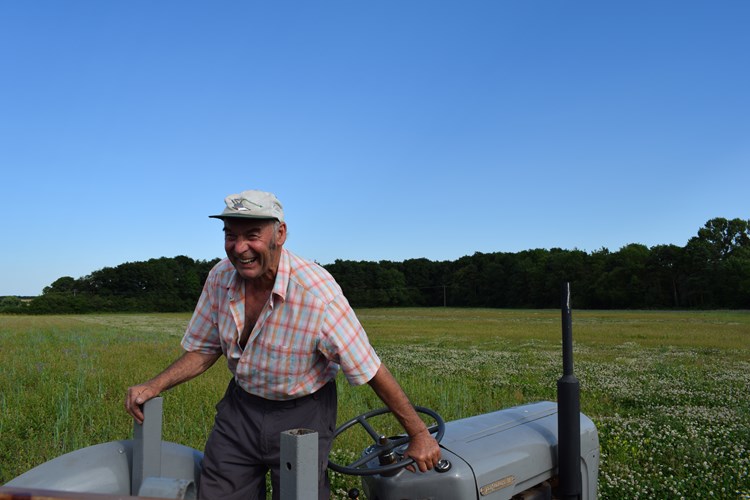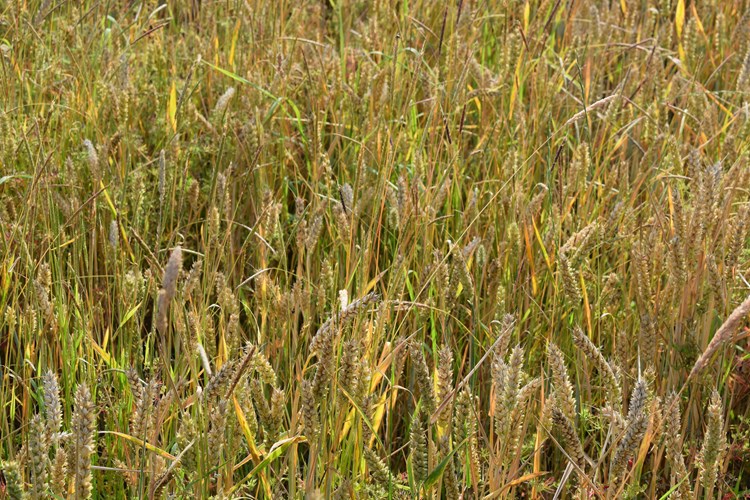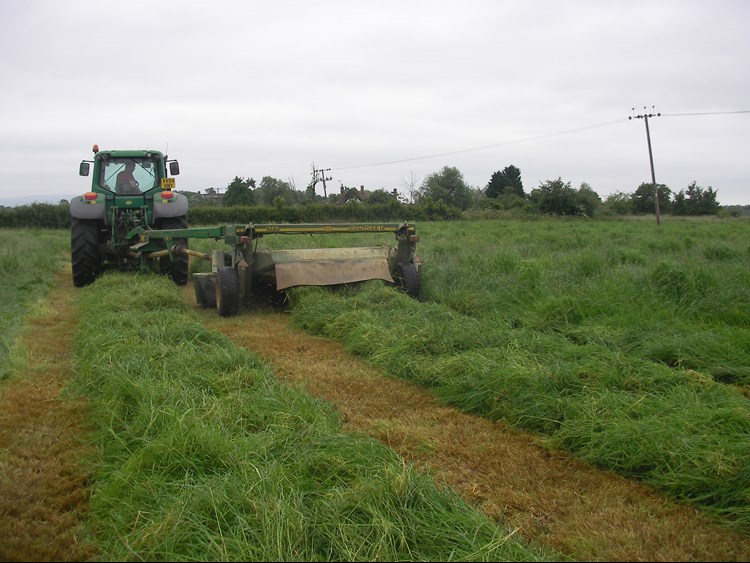Digging the Dirt on Curlew Call Farm
Digging the Dirt: A series of in-depth reports of farms which are reaping the benefits of investing in their soil, and how they've done it.
“We’ve been endeavouring to maintain soil organic matter for many many years, having learnt the lesson about 30 years ago that you just can’t take it for granted. If you keep on with cereal production without using farm yard manure or grass leys, the soil will essentially die on you. Though it is possible to grow a crop off it, it isn’t easy. You’re fighting the elements and you’re putting a lot of stuff on which really isn’t always desirable. You can achieve the same level of success growing crops in a much more environmentally friendly way by using green manures and grass leys.” – Jonathan Boaz, arable farmer, West Midlands
Why the soil matters to Jonathan Boaz
Back in 1968, Jonathan remembers half his local area was made up of family mixed and dairy farms. Now there are only 3 dairy farms left. He thinks the subsidy system is to blame – it favours arable farming and has led to the dramatic loss of mixed farms, and the subsequent lack of organic manure has taken its toll on the soil. Farms that used to have livestock can often still see the effects decades later, with the most fertile field being the one at the back of the farmyard – where it used to get the most manure.
Jonathan has a particular soil problem with poor phosphate availability. He struggles to keep his soils at an index of 2 for phosphate. Potash is not a problem though, as the clay content of the soil is high enough to provide sufficient for his crop needs. In fact his potash indices are usually around 3-4. Although his soils are grade 3, he regularly achieves wheat yields of 9-10 tonnes per hectare, so this will be removing large quantities of both P and K. A local all-grass dairy farm that Jonathan sells forage to has P and K levels at 4s and 5s, which shows what is possible with the local soils. However, P and K will be arriving onto the farm in the form of cattle feed and straw. The only fertiliser used is Nitrogen.
Jonathan tests his soils every 4 years to monitor his management practices. Most of his soils are at pH 7 – 8 with only some areas of lighter land needing lime which he applies as the pH reduces to a value of 6.0. Magnesium levels are generally very high (4 and above) which does make the soil difficult to work but Jonathan says he has learned to live with it.

Controlling Blackgrass
Jonathan sees a good opportunity to control blackgrass following the early harvest of a winter barley crop – at the end of July. He ploughs immediately after harvest and creates a stale seedbed to encourage blackgrass seed to chit which he then controls with glyphosate .*
A straight westerwold seed is sown in late September and will not be ploughed again for several years, to avoid bringing back up viable blackgrass seed. The westerwolds is a useful cash crop, as well as being helpful in suppressing blackgrass. A silage crop is taken by mid-May, then a seeds hay crop in late July and lamb grazing in the autumn. The hay crop self-seeds the westerwolds back into the sward to which Jonathan also broadcasts red and white clover seed to add some valuable legumes. The seeds are then trampled in by the lambs over the autumn and winter as they graze.
The return on this crop is good given the minimal inputs. The silage is sold at £50 per acre (£125 per hectare), the hay for £70 per acre (£175 per hectare).The lamb grazing is charged at 60p per head per week, but half of this is to cover labour, so the farm receives 30p per head with a typical stocking rate of 10-12 per hectare For 6 months grazing this is worth about £86 per hectare. On top of the cash receipts is the very valuable sheep manure from the grazing animals to boost soil fertility.

Rotation
Although Jonathan is not an organic farmer, his rotation does not differ greatly from an organic one with a long period of soil fertility building. In summary he grows 3 years of cereals followed by 4-5 years of grass leys.
The cereals are typically 2 years of winter wheat grown for feed followed by hybrid winter barley. The latter has very vigorous growth which competes with blackgrass.
Jonathan has experimented with many grass leys and uses a mix designed for HLS agreements – legume and herb rich sward (HLS code EK21, or CS code GS4) which provides pollen and nectar, soil conditioning and top quality grazing and forage. Jonathan keeps this ley down for 5 years before going back to wheat; it is used for sheep grazing and for a hay crop each year. Although the hay can look stalky, it is very good fodder for beef cattle who enjoy it. Jonathan has also used a cockle park ley, lucerne and a clover mix of Red, Crimson, Persian and Sweet in his rotation. He has learned not to take a silage cut too early from the clover mix as when he did it knocked it back severely. To increase the diversity on simple grass swards he brush harvests from the legume and herb rich swards and spreads this on the swards; this helps reduce his seed costs. The lucerne is a valuable cash crop from which he gets 3-4 crops each year for high quality hay sales.
All the wheat is sold to a local feed mill which works well for Jonathan as he receives prompt payments and gets no rejections. To reduce his risk he spread his sales over the year with one third sold before Christmas, another third before Easter and the remainder before the new season.

Cultivations
Minimum tillage is replacing routine ploughing. The sward surface is broken up with heavy discs and then chisel harrowed; starting shallow then going deeper. No herbicides are used to kill off the sward. Jonathan’s home-made compost is then spread on the top of the cultivated soil. It is easier to incorporate into this previously worked soil tilth. He uses a 16 tonne spreader that provides a good even coverage up to 24 metres wide and at a rate of 10 tonnes per hectare together with a further 20 t/ha of farm yard manure.
Jonathan does not chase maximum wheat yields but rather a cost effective yield – he believes there is a law of diminishing returns (and his soils are grade 3). But the price of wheat is worrying and is affecting his cropping programme. The total farmed area is 600 acres with 200 acres of permanent pasture, and of the 400 acres of the rotational land only 140 acres is cereals; this was up to 300 acres. He doesn’t want to expose himself to the risk of growing wheat at the present prices – instead he puts more into soil improving grass leys and he has no problem selling hay which averages £60 per tonne out of the barn.
An important cost on all arable farms is machinery and this is well controlled by Jonathan. He has his own well kitted out workshop and takes care of tractors and machinery, often selling equipment for more than he paid for it. Most machinery is kept for a long time with only an occasional new purchase such as a telehandler. Jonathan is confident that the total value of his machinery is less than one top of the range modern combine harvester.

Why compost and farm yard manure?
Jonathan sees an obvious increase in worm activity and finds the soil easier to work following applications of compost and farm yard manure. The soil biology gets to work on all this organic matter, releasing plant available nutrients into the soil. The visual result is a healthy crop of wheat.
All the farm yard manure used on the farm is imported, and is readily available and free if Jonathan is prepared to clean out neighbouring farmer’s livestock sheds and transport it home. A lot of his neighbours are in Nitrate Vulnerable Zones and need to lose some farm yard manure; this way he brings in 1,500 tonnes a year. There is also a small local supply of horse manure to help.
Compost making
Jonathan’s interest in soil health brought him to the idea of using a good quality living compost to further boost his soils, not only will this add organic matter but should also contain beneficial soil organisms. The source material is mostly at hand -straw from his cereal crops, a source of farm yard manure from neighbouring livestock farms, he makes wood chip from trees on his farm; and green forage mostly resulting from a last lucerne cut taken too late in the year to make into hay. All this has been costed out allowing for mixing and spreading and comes to £32.61 per tonne, so not insignificant. The woodchip is the most expensive ingredient, costing £50 - £60 per tonne to produce, but it is needed to encourage a greater fungal life into the soil. For the necessary regular mixing and turning of the compost, Jonathan has purchased a windrow turner to speed up the process. Woodchip has so far come from pollarded willows on the farm and in the future will come from a willow plantation.
A new idea has been to add a source of phosphate to the compost to help his low soil indices. Jonathan has recently found a source of phosphate called TigerPhos** arising from heating plants that incinerate livestock waste. This is a very cost effective option compared to other sources of P and is predicted to have an effect in the soil for 4 years. The product comes as a dust and can be mixed into the compost with the windrow turner. This will save an extra field operation applying the phosphate.
The importance of livestock
Jonathan has seen a change in farming systems over the years and in particular he noticed the ploughing out of pastures in the late 1960s. The natural fertility of these soils was cashed in but after 4 - 5 years he noticed the soil decline from growing continuous cereals. Quickly he saw the need to bring back livestock and re-introduced a paddock grazing system with livestock for the valuable manure.
In the 1980s the farm did own a lot of livestock – 1,000 lambing ewes, 80 suckler cows, 2,000 turkeys and a few pigs – so why no livestock now? Jonathan states several reasons; he says livestock are hard work, they are too highly regulated and he is much happier working with machinery than animals. He has also found a very good grazier to let his grass leys to, so he has the benefits of the manure but none of the responsibility. Disease outbreaks are also a concern but it was never an economic decision not to own livestock.
The permanent pasture on the farm, not ploughed since the 1970s, gives good yields of hay for sale with the only input being manure from sheep grazed on the aftermath.
Jonathan sees the advantage of grazed root crops as an addition to soil health. The seed is relatively cheap at £8 per acre and is strip grazed with sheep, returning the biomass as manure with no costly field operations. Jonathan is a great advocate of livestock even if he does not wish to own any himself.
*This could be done by simply disturbing the seed bed again, rather than using glyphosate for organic farmers
** This product is not available for use by organic farmers


